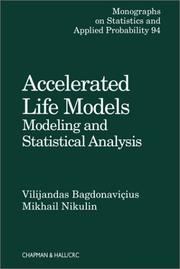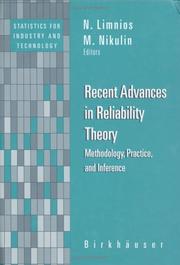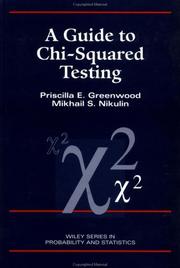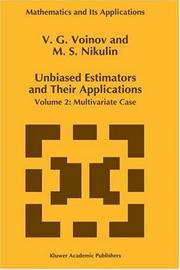| Listing 1 - 10 of 17 | << page >> |
Sort by
|
Book
ISBN: 0817649239 9786612927928 1282927922 0817649247 Year: 2009 Publisher: Boston : Birkhauser,
Abstract | Keywords | Export | Availability | Bookmark
 Loading...
Loading...Choose an application
- Reference Manager
- EndNote
- RefWorks (Direct export to RefWorks)
This volume—dedicated to William Q. Meeker on the occasion of his sixtieth birthday—is a collection of invited chapters covering recent advances in accelerated life testing and degradation models. The book covers a wide range of applications to areas such as reliability, quality control, the health sciences, economics, and finance. Specific topics covered include: * Accelerated testing and inference * Step-stress testing and inference * Nonparametric inference * Model validity in accelerated testing * The point process approach * Bootstrap methods in degradation analysis * Exact inferential methods in reliability * Dynamic perturbed systems * Degradation models in statistics Advances in Degradation Modeling is an excellent reference for researchers and practitioners in applied probability and statistics, industrial statistics, the health sciences, quality control, economics, and finance.
Accelerated life testing --- Accelerated testing --- Life testing, Accelerated --- Reliability testing --- Statistical methods. --- Mathematics. --- Probabilities. --- Statistics. --- Probability Theory and Stochastic Processes. --- Statistical Theory and Methods. --- Statistics for Life Sciences, Medicine, Health Sciences. --- Statistics for Business/Economics/Mathematical Finance/Insurance. --- Testing --- Distribution (Probability theory. --- Mathematical statistics. --- Statistics for Business, Management, Economics, Finance, Insurance. --- Statistical analysis --- Statistical data --- Statistical methods --- Statistical science --- Mathematics --- Econometrics --- Statistical inference --- Statistics, Mathematical --- Statistics --- Probabilities --- Sampling (Statistics) --- Distribution functions --- Frequency distribution --- Characteristic functions --- Statistics . --- Probability --- Combinations --- Chance --- Least squares --- Mathematical statistics --- Risk

ISBN: 1584881860 Year: 2002 Publisher: Boca Raton (Fla.) : Chapman & Hall/CRC,
Abstract | Keywords | Export | Availability | Bookmark
 Loading...
Loading...Choose an application
- Reference Manager
- EndNote
- RefWorks (Direct export to RefWorks)
Survival analysis is an important and widely used technique, particularly to those working in reliability, survival analysis, life testing, and engineering, as well as to probabilists and statisticians. The authors of Accelerated Life Models: Modeling and Statistical Analysis have developed a large and important class of survival analysis models that generalize most of the existing models. In a unified, systematic presentation, this monograph details those accelerated life models. This treatment is valuable as both a high-level textbook and as a reference.
Mathematical statistics --- Accelerated life testing --- Mathematical models. --- Statistical methods.

ISBN: 0817641351 9780817641351 3764341351 9783764341350 Year: 2000 Publisher: Boston Birkhauser
Abstract | Keywords | Export | Availability | Bookmark
 Loading...
Loading...Choose an application
- Reference Manager
- EndNote
- RefWorks (Direct export to RefWorks)
Stochastic processes --- Reliability (Engineering) --- Mathematical models

ISBN: 047155779X 9780471557791 Year: 1996 Publisher: New York (N.Y.) : Wiley,
Abstract | Keywords | Export | Availability | Bookmark
 Loading...
Loading...Choose an application
- Reference Manager
- EndNote
- RefWorks (Direct export to RefWorks)
The first step-by-step guide to conducting successful Chi-squared testsChi-squared testing is one of the most commonly applied statistical techniques. It provides reliable answers for researchers in a wide range of fields, including engineering, manufacturing, finance, agriculture, and medicine.A Guide to Chi-Squared Testing brings readers up to date on recent innovations and important material previously published only in the former Soviet Union. Its clear, concise treatment and practical advice make this an ideal reference for all researchers and consultants.Authors Priscilla E. Greenwood and Mikhail S. Nikulin demonstrate the application of these general purpose tests in a wide variety of specific settings. They alsoDetail the various decisions to be made when applying Chi-squared tests to real data, and the proper application of these tests in standard hypothesis-testing situationsDescribe how Chi-squared type tests allow statisticians to construct a test statistic whose distribution is asymptotically Chi-squared, and to compute power against various alternativesDevote half of the book to examples of Chi-squared tests that can be easily adapted to situations not covered in the bookProvide a self-contained, accessible treatment of the mathematical requisitesInclude an extensive bibliography and suggestions for further reading
Mathematical statistics --- Chi-square test --- Chi-square test.

ISBN: 0792323823 0792339398 9401048703 9401119708 Year: 1993 Publisher: Dordrecht Kluwer
Abstract | Keywords | Export | Availability | Bookmark
 Loading...
Loading...Choose an application
- Reference Manager
- EndNote
- RefWorks (Direct export to RefWorks)
Book
ISBN: 0123977835 1299196144 0123971942 9781299196148 9780123977830 9780123971944 Year: 2013 Publisher: Waltham, MA Academic Press
Abstract | Keywords | Export | Availability | Bookmark
 Loading...
Loading...Choose an application
- Reference Manager
- EndNote
- RefWorks (Direct export to RefWorks)
"If the number of sample observations n ! 1, the statistic in (1.1) will follow the chi-squared probability distribution with r-1 degrees of freedom. We know that this remarkable result is true only for a simple null hypothesis when a hypothetical distribution is specified uniquely (i.e., the parameter is considered to be known). Until 1934, Pearson believed that the limiting distribution of the statistic in (1.1) will be the same if the unknown parameters of the null hypothesis are replaced by their estimates based on a sample; see, for example, Baird (1983), Plackett (1983, p. 63), Lindley (1996), Rao (2002), and Stigler (2008, p. 266). In this regard, it is important to reproduce the words of Plackett (1983, p. 69) concerning E. S. Pearson's opinion: "I knew long ago that KP (meaning Karl Pearson) used the 'correct' degrees of freedom for (a) difference between two samples and (b) multiple contingency tables. But he could not see that in curve fitting should be got asymptotically into the same category." Plackett explained that this crucial mistake of Pearson arose from to Karl Pearson's assumption "that individual normality implies joint normality." Stigler (2008) noted that this error of Pearson "has left a positive and lasting negative impression upon the statistical world." Fisher (1924) clearly showed 1 2 CHAPTER 1. A HISTORICAL ACCOUNT that the number of degrees of freedom of Pearson's test must be reduced by the number of parameters estimated from the sample"--
Chi-square test. --- Distribution (Probability theory). --- Statistical hypothesis testing. --- Chi-square test --- Distribution (Probability theory) --- Mathematics --- Physical Sciences & Mathematics --- Mathematical Statistics --- Distribution functions --- Frequency distribution --- Characteristic functions --- Probabilities --- Statistical hypothesis testing
Multi
ISBN: 1299196144 9781299196148 9780123977830 0123977835 9780123971944 0123971942 Year: 2013 Publisher: Amsterdam : Academic Press,
Abstract | Keywords | Export | Availability | Bookmark
 Loading...
Loading...Choose an application
- Reference Manager
- EndNote
- RefWorks (Direct export to RefWorks)
"If the number of sample observations n ! 1, the statistic in (1.1) will follow the chi-squared probability distribution with r-1 degrees of freedom. We know that this remarkable result is true only for a simple null hypothesis when a hypothetical distribution is specified uniquely (i.e., the parameter is considered to be known). Until 1934, Pearson believed that the limiting distribution of the statistic in (1.1) will be the same if the unknown parameters of the null hypothesis are replaced by their estimates based on a sample; see, for example, Baird (1983), Plackett (1983, p. 63), Lindley (1996), Rao (2002), and Stigler (2008, p. 266). In this regard, it is important to reproduce the words of Plackett (1983, p. 69) concerning E. S. Pearson's opinion: "I knew long ago that KP (meaning Karl Pearson) used the 'correct' degrees of freedom for (a) difference between two samples and (b) multiple contingency tables. But he could not see that in curve fitting should be got asymptotically into the same category." Plackett explained that this crucial mistake of Pearson arose from to Karl Pearson's assumption "that individual normality implies joint normality." Stigler (2008) noted that this error of Pearson "has left a positive and lasting negative impression upon the statistical world." Fisher (1924) clearly showed 1 2 CHAPTER 1. A HISTORICAL ACCOUNT that the number of degrees of freedom of Pearson's test must be reduced by the number of parameters estimated from the sample"--
Book
Abstract | Keywords | Export | Availability | Bookmark
 Loading...
Loading...Choose an application
- Reference Manager
- EndNote
- RefWorks (Direct export to RefWorks)
Digital
ISBN: 9780817649715 9780817649708 9780817649722 Year: 2010 Publisher: Boston, MA Birkhäuser Boston :Imprint: Birkhäuser
Abstract | Keywords | Export | Availability | Bookmark
 Loading...
Loading...Choose an application
- Reference Manager
- EndNote
- RefWorks (Direct export to RefWorks)
An outgrowth of the sixth conference on “Mathematical Methods in Reliability: Theory, Methods, and Applications,” this book is a selection of invited chapters, all of which deal with various aspects of mathematical and statistical models and methods in reliability. Written by recognized experts in the field of reliability, the contributions cover a wide range of models, methods, and applications, reflecting recent developments in areas such as survival analysis, aging, lifetime data analysis, artificial intelligence, medicine, carcinogenesis studies, nuclear power, financial modeling, aircraft engineering, quality control, and transportation. The volume is thematically organized into four major sections: * Reliability Models, Methods, and Optimization; * Statistical Methods in Reliability; * Applications; * Computer Tools for Reliability. Mathematical and Statistical Models and Methods in Reliability is an excellent reference text for researchers and practitioners in applied probability and statistics, industrial statistics, engineering, medicine, finance, transportation, the oil and gas industry, and artificial intelligence.
Statistical science --- Operational research. Game theory --- Probability theory --- Mathematics --- Biomathematics. Biometry. Biostatistics --- Hygiene. Public health. Protection --- Applied physical engineering --- Planning (firm) --- Plant and equipment --- Production management --- betrouwbaarheid --- medische statistiek --- toegepaste wiskunde --- waarschijnlijkheidstheorie --- stochastische analyse --- veiligheid (bouw) --- biostatistiek --- economie --- mathematische modellen --- statistiek --- wiskunde --- kwaliteitscontrole --- kansrekening --- statistisch onderzoek
Book
ISBN: 1280460962 9786610460960 0387260234 Year: 2006 Publisher: New York, NY : Springer Science+Business Media,
Abstract | Keywords | Export | Availability | Bookmark
 Loading...
Loading...Choose an application
- Reference Manager
- EndNote
- RefWorks (Direct export to RefWorks)
Probability, Statistics and Modelling in Public Health consists of refereed contributions by expert biostatisticians that discuss various probabilistic and statistical models used in public health. Many of them are based on the work of Marvin Zelen of the Harvard School of Public Health. Topics discussed include models based on Markov and semi-Markov processes, multi-state models, models and methods in lifetime data analysis, accelerated failure models, design and analysis of clinical trials, Bayesian methods, pharmaceutical and environmental statistics, degradation models, epidemiological methods, screening programs, early detection of diseases, and measurement and analysis of quality of life. Audience This book is intended for researchers interested in statistical methodology in the biomedical field.
Public health --- Medical statistics. --- Probability measures. --- Statistical methods. --- Measures, Normalized --- Measures, Probability --- Normalized measures --- Distribution (Probability theory) --- Health --- Health statistics --- Medicine --- Statistics --- Community health --- Health services --- Hygiene, Public --- Hygiene, Social --- Public health services --- Public hygiene --- Sanitary affairs --- Social hygiene --- Human services --- Biosecurity --- Health literacy --- Medicine, Preventive --- National health services --- Sanitation --- Statistical methods --- Statistics. --- Statistics for Life Sciences, Medicine, Health Sciences. --- Statistical analysis --- Statistical data --- Statistical science --- Mathematics --- Econometrics --- Statistics .
| Listing 1 - 10 of 17 | << page >> |
Sort by
|

 Search
Search Feedback
Feedback About UniCat
About UniCat  Help
Help News
News